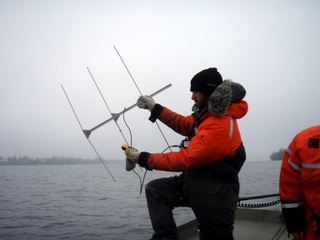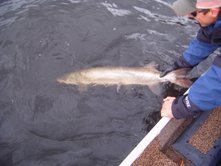|
|
Posts: 83
| I thought I'd go through my video archives and string together some footage of walleye and muskie interacting down there. The relationship isn't what I thought it was, and it took some time for me to grasp that this WAS the normal for these fish.
I think I'd heard so much lore, so much BS, that I believed that everything else was just bait, and that the muskie was an underwater monster. That a Walleye was a meek victim. As very few have dove with the fish before I guess there is a lot to learn about them.
Anyways, watch the video here, and we can kick around what it means over the upcoming off months instead of discrediting the fish of dead guys.
All questions and comments welcome.
http://www.youtube.com/watch?v=oRIE5nCdES8<object
| |
| | |

Posts: 2024
| Hi Jim,
Firstly, this is amazing underwater footage, all of your videos are! Capturing footage of muskies in their natural environment is quite unique. Well done!
You've raised some interesting questions in your video. The idea that muskellunge are responsible for the "collapse" (I use quotation marks here because what fishermen perceive as a stock failure are 9 times out of 10 simply not, but their inability to catch the fish) of walleye, bass, crappie, or any other fishery is a fallacy in my opinion. Behavior is driven by two things: genetics and environmental variables. The behavior of muskellunge around walleyes and bass that are present in your videos, to me, suggests that muskellunge have 1) become genetically programmed to respond aggressively toward some other stimuli (e.g., the darting motions or colorations/profile of perch or suckers) and 2) have an abundance of other food sources available to them.
You also have natural selection probably working in favor of walleye here (and everywhere). Walleye are quite scaly and possess big, spiny dorsal fins which are problematic for predators to consume (i.e., they're the walleyes natural defense against predation). As well, walleye fin position (don't forget bass and other centrarchids have similar fin position) enables them to corner/maneuver easily making them a difficult target to hit. Once upon a time muskellunge may have tried to prey upon fishes like walleye, but those that did likely were unsuccessful to the point that natural selection weeded out that phenotype (the characteristics that define an organism as the result of the interaction between genes and the environment). Phenotypes that preferred slower moving prey such as suckers or prey in more abundance like cyprinids (shiners, minnows, etc.) or perch. Perhaps the easiest explanation is that walleye aren't preyed upon as much because there aren't as many around. I can go to the grocery store and buy a grade A Angus steak, but I'd have to expend a lot of energy finding a kobe steak; it's not worth it to me and it's not worth it to the fish trying to find something that isn't in high abundance. This is called the "optimal foraging theory" and is a classic principle that many believe drives animal behavior. There are variations on this theory and some with caveats, but this is a fairly simple way to possibly explain a lot of animal behavior.
As far as your observation that muskellunge and walleye appear to be living in symbiosis (sympatry is technically referring to the overlapping geographical distributions of organisms), I agree. Here's a quick list of animal (or plant) interactions where positive (+), negative (-), and neutral (0) interactions exists: mutualism (+/+, both organisms benefit), symbiosis (+/+, +/-, or +/0), antagonism (-/-), amensalism (-/0), comensalism (+/0), etc. It's my opinion that muskie/walleye or muskie/bass interactions are not necessary mutualistic as we know there is some predation occuring, but very likely they are symbiotic (+/+ or +/-). Muskellunge may prefer to feed on the same forage fishes as walleyes, but at slightly larger sizes. This leaves plenty food for both species and as the larger ones are culled that leaves room for smaller fish to fill the void (or bellies of walleyes and bass in this case). The foraging tactics of one species may also benefit the other. Where walleye and bass are more active foragers, muskellunge are more sit and wait. Active foraging may cause prey to run for cover... right where muskellunge are waiting in ambush. A friend has conducted a study indicating this, but the results have yet to be published in peer-reviewed journals.
Bottom line is yes these two species co-exist just fine. Same holds true for bass. Do muskellunge prey on walleye and bass? Yes. They are apex predators that feed opportunistically (think sharks). If I'm hungry and see a piece of tofu on the counter I'll probably eat it, though I may gag in the process, but I won't pass it up. Muskellunge that see a walleye in distress or that may simply move in a way that triggers their predatory instinct is going to probably come face to face with the business end of a muskellunge's head.
Thanks for sharing such great footage, and for sitting through my ramblings. I had to dig into a couple old textbooks, but I probably had as much fun writing this as you did creating your video (OK, maybe not as much). | |
| | |

Posts: 32944
Location: Rhinelander, Wisconsin | Nice work, gentlemen. | |
| | |
Posts: 83
| Thanks for the reply Sean
We tend to lump all fish behavior into food/feeding or spawning based activity. For a smallmouth bass, I think you may be able to do that. For the musky/walleye relationship, and muskies in general, It goes a little deeper. I have had instances where a musky has interjected itself between a diver and a walleye, or other muskie. Check out the last clip where the fish charges me. It's almost as if they "Catch the back" of the other fish. I would say they are far more social that they are given credit for
For some reason, the underwater footage was degraded when compressed for youtube, but the fish are not on bait in any of the clips.
I've seen what appears to be the same musky and walleye hanging together for extended periods. The same two fish on a dive a week later.
A dog and a cat will share the same household and have friendly relations. Sometimes they even lay together. The dog could possibly attack and eat the cat, the cat could give a good account of himself with his quickness and formidable claws. It doesn't come down to that. While the two animals have occasional disagreements, they don't usually harm each other. The dog may defend the cat in certain situations. They both have some degree of intelligence, yet shine a laser pointer, and the cat is compelled by instinct to chase it, throw a stick, and the dog wants to run after it. To say a that these fish have as much smarts as dogs and cats goes a bit too far, but not by all that much. That's as close as I can come with a land based comparison.
| |
| | |
Posts: 540
Location: MN | WOW this is way better than dead muskies. Thanks guys that's a lot of good info there. | |
| | |

Posts: 32944
Location: Rhinelander, Wisconsin | jimkinner,
Our upload site now preserves the original integrity of your video using our server side encoder. Upload it to upload.outdoorsfirst.com, no watermark and full screen clarity streamed from the OutdoorsFIRST servers. | |
| | |
Posts: 2361
| Always interesting to see underwater video, but I would be leery of doing too much interpretation of footage this limited.
Big meal eaters are not frequent feeders. | |
| | |
Posts: 83
| There are about a dozen instances shown. Thats nothing approaching a scientific sample size. Is there any data showing that muskies ARE a significant predator of walleye? There must be some stomach content surveys out there somewhere.
As I said , this could be unique to the Niagara. But I tend to believe what I see over how some one else thinks it must be. I sure can't say it's like this everywhere. But I do know what I saw, and recorded what I could, so you could see it as well.
I've met some people involved in this sport that have almost religious beliefs about these fish. True fanatics.
I saw a whole show about a monster muskie based on a piece of jawbone. You are looking at quite a bit more than that here.
| |
| | |

Posts: 553
Location: 15 miles east of Lake Kinkaid | Very interesting video Jim and excellent ethology explanation Sean. As a graduate student in the sciences as well, I appreciate the scientific analysis. As was mentioned, I believe muskies are often used as a scapegoat for the inability of certain anglers to catch panfish, walleyes, perch, bass, etc. on a certain lake. This past spring, I had a musky grab a bluegill as I was pulling it out of the water. I know most anglers who spend a lot of time on lakes with pike or muskies present will have a similar experience when reeling in a walleye, bass, perch, or other panfish. What I believe some anglers do no understand is that the distress signals, whether they be audible or visual (swimming erratically), that are sent out from a fish on a hook and line is much different than "normal" behavior. It presents an easy meal to a musky, even if the meal is not usual forage. Numerous times while fishing offshore ledges in the gulf, while reeling in red snapper or small gag and red grouper, I have had porpoises eat them right off my hook. Has anyone blamed porpoises for the collapse of the Gulf snapper fishery? I highly doubt porpoises, with their pelagic nature, rarely encounter red snapper or either species of grouper because of their benthic nature. However, when the snapper or grouper were being reeled in and displayed as vunerable to the porpoises, they had no problem using them as a food source. | |
| |
|
 Walleye Muskie interactions
Walleye Muskie interactions Walleye Muskie interactions
Walleye Muskie interactions